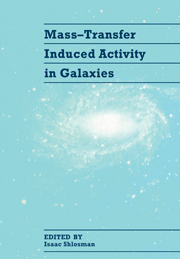Book contents
- Frontmatter
- Contents
- Preface
- List of Participants
- I INTRODUCTION
- II THE INNER PARSEC
- Angular Momentum Transfer in the Inner Parsec (Invited paper)
- Can Supernovae and Accretion Disks be Distinguished Spectroscopically?
- Low Ionization Broad Absorption Lines in Quasars
- The Aftermath of Tidal Disruption
- The Galactic Center — an AGN on a Starvation Diet (Poster talk)
- A Central Black Hole in M32? (Poster paper)
- Stars and Disks around Massive Black Holes (Poster paper)
- Accretion onto Massive Binary Black Holes (Poster paper)
- Profile Variations of Broad-Line Radio Galaxies (Poster paper)
- The Budget of Energy in AGNs and Quasars (Poster paper)
- The Detection of Microvariations for Akn 120 (Poster paper)
- The Contribution of Cool-Wind Reprocessing to AGN Spectra (Poster paper)
- III THE CIRCUMNUCLEAR REGION
- IV GAS DYNAMICS AND STAR FORMATION IN BARRED AND NORMAL GALAXIES
- V NUCLEAR GAS AND LARGE-SCALE PROPERTIES OF AGN AND STARBURST HOSTS
- VI HOST GALAXY-AGN-NUCLEAR STARBURST CONNECTION
- VII GALAXY INTERACTIONS AND INDUCED ACTIVITY
- VIII GAS DYNAMICS IN ELLIPTICALS
- IX AGN AND STARBURST HOSTS AT LARGE REDSHIFTS
- X CONFERENCE SUMMARY
- Subject Index
- Object Index
- Author Index
Angular Momentum Transfer in the Inner Parsec (Invited paper)
Published online by Cambridge University Press: 05 May 2010
- Frontmatter
- Contents
- Preface
- List of Participants
- I INTRODUCTION
- II THE INNER PARSEC
- Angular Momentum Transfer in the Inner Parsec (Invited paper)
- Can Supernovae and Accretion Disks be Distinguished Spectroscopically?
- Low Ionization Broad Absorption Lines in Quasars
- The Aftermath of Tidal Disruption
- The Galactic Center — an AGN on a Starvation Diet (Poster talk)
- A Central Black Hole in M32? (Poster paper)
- Stars and Disks around Massive Black Holes (Poster paper)
- Accretion onto Massive Binary Black Holes (Poster paper)
- Profile Variations of Broad-Line Radio Galaxies (Poster paper)
- The Budget of Energy in AGNs and Quasars (Poster paper)
- The Detection of Microvariations for Akn 120 (Poster paper)
- The Contribution of Cool-Wind Reprocessing to AGN Spectra (Poster paper)
- III THE CIRCUMNUCLEAR REGION
- IV GAS DYNAMICS AND STAR FORMATION IN BARRED AND NORMAL GALAXIES
- V NUCLEAR GAS AND LARGE-SCALE PROPERTIES OF AGN AND STARBURST HOSTS
- VI HOST GALAXY-AGN-NUCLEAR STARBURST CONNECTION
- VII GALAXY INTERACTIONS AND INDUCED ACTIVITY
- VIII GAS DYNAMICS IN ELLIPTICALS
- IX AGN AND STARBURST HOSTS AT LARGE REDSHIFTS
- X CONFERENCE SUMMARY
- Subject Index
- Object Index
- Author Index
Summary
ABSTRACT
I discuss the various processes which may affect the transfer of angular momentum in gas within the inner parsec surrounding a supermassive black hole. Even after gas has been brought into the gravitational sphere of influence of the black hole, it still has 100–1000 times too much angular momentum to reach the event horizon. Angular momentum loss cannot be accommodated in a scaled-up standard thin accretion disk model, because local self-gravitational instabilities will lead to fragmentation of the disk, which will decrease the efficiency of angular momentum transport. Instead, some nonlocal mechanism or “external” trigger for angular momentum transfer is needed, such as a large-scale magnetized wind, stirring by winds from massive stars and supernovae, or global gravitational instabilities.
INTRODUCTION
Most participants in this conference seem to agree that large-scale, non-axisym-metric gravitational disturbances can be very effective in transferring angular momentum on scales of hundreds of parsecs or larger. These disturbances might be driven by tidal encounters or may be “self-starting”, as in the “bars-in-bars” scenario. What is less certain is whether similar mechanisms can be effective all the way into the nucleus, say, into the inner parsec surrounding a supermassive black hole. Gravitational triggers for inflow usually involve at least a mild form of self-gravitational instability, which requires that the stars plus gas constitute a significant fraction of the total mass enclosed within the region under consideration (see, e.g., Friedli, these proceedings).
- Type
- Chapter
- Information
- Mass-Transfer Induced Activity in Galaxies , pp. 23 - 29Publisher: Cambridge University PressPrint publication year: 1994
- 5
- Cited by

